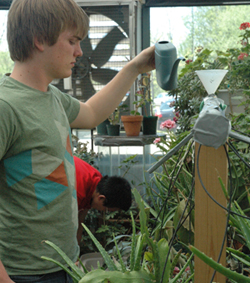
Okemos High School junior Zach Trelstad feeds water into an irrigation system built for a class.
By Andy Balaskovitz, abalaskovitz@gmail.com
Great Lakes Echo
July 1, 2009
On the west side of Michigan’s Okemos High School is Zach Trelstad’s favorite classroom. To the right of the greenhouse entrance is the sandy ground with desert-native plants. To the left is the tropical area filled with large overhanging leaves, ponds with amphibians and intricate vines on lattice. It’s about the same size as a regular classroom but filled with sunlight and plants instead of light bulbs and desks.
“When I whisper at them, the frogs will croak back pretty loudly,” said Trelstad whose independent study in this mid-Michigan school’s greenhouse is one of his favorite school experiences.
“I’m more into this class than any other one where I’ve sat inside and listened to the teacher,” he said.
During their junior year Trelstad and two other students maintained plants and provided general greenhouse upkeep. Walter Chou developed a new irrigation system, Emerson Hendry built the tropical vine structure and Trelstad moderated the temperature between the desert and tropical sections.
All three took plant cuttings to transplant and later sell or donate. They learned the tricks of the trade on the job.
“It’s a trial and error kind of learning,” Trelstad said.
The class adviser, Dave Chapman, is a science teacher who allows a great deal of freedom.
“It takes responsibility because students are in charge,” Trelstad said.
And there are unexpected benefits
“It’s a really good end to the day, I look forward to it, Trelstad said. “The scenery puts me in a good mood. There are no fluorescents out here.”
When Okemos High School was built 16 years ago, Chapman said there was interest in building a greenhouse as a teaching tool. While it initially just kept plants alive, now multiple disciplines use it, including biology, photography, conservation and special education classes.
“This is a wonderful resource,” Chapman said. “What’s most useful to us is not a room with a bunch of tables.”
A few years ago, he successfully applied for a state grant to build the ponds, waterfall and the partition between habitats. The greenhouse also receives donations from local businesses and MSU.

Okemos High School junior Walter Chou scoops water for the hydroponics tank where the class studies how fish fertilize plants.
“It allowed us to create ecosystems right here,” he said. “I feel very privileged to have it.”
Chapman acknowledges that not all schools can win grants or may not have community support. But that shouldn’t deter them from doing outdoor, hands-on teaching, he said. Active ecosystems are right outside many schools.
“I’m a real advocate for looking outside your own building,” he said. “The state doesn’t have a lot of money to do these things.”
Outdoor projects can be as simple as studying mice or dandelion populations or building small garden plots — all relevant projects for Michigan students, he said.
Integrating environmental education into Michigan’s public school curricula has evolved over decades. Even with funding in short supply, every year there are new projects created by teachers . For those who seek to inspire students like Trelstad, Hendry and Chou have been, the resources are growing every day.
“There are a lot more folks everyday getting excited about the environmental situation and passing that on to students,” said Doug Russell, executive director of Michigan GREEN, an energy education consulting group.
“It’s been a long time coming for some folks and they’re glad to see it in schools more.”